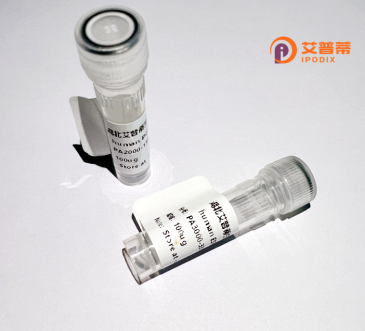
| 纯度 | >90%SDS-PAGE. |
| 种属 | Human |
| 靶点 | OR4K5 |
| Uniprot No | Q8NGD3 |
| 内毒素 | < 0.01EU/μg |
| 表达宿主 | E.coli |
| 表达区间 | 1-323 aa |
| 活性数据 | MDKSNSSVVSEFVLLGLCSSQKLQLFYFCFFSVLYTVIVLGNLLIILTVTSDTSLHSPMY FLLGNLSFVDICQASFATPKMIADFLSAHETISFSGCIAQIFFIHLFTGGEMVLLVSMAY DRYVAICKPLYYVVIMSRRTCTVLVMISWAVSLVHTLSQLSFTVNLPFCGPNVVDSFFCD LPRVTKLACLDSYIIEILIVVNSGILSLSTFSLLVSSYIIILVTVWLKSSAAMAKAFSTL ASHIAVVILFFGPCIFIYVWPFTISPLDKFLAIFYTVFTPVLNPIIYTLRNRDMKAAVRK IVNHYLRPRRISEMSLVVRTSFH |
| 分子量 | 36.2 kDa |
| 蛋白标签 | His tag N-Terminus |
| 缓冲液 | 0 |
| 稳定性 & 储存条件 | Lyophilized protein should be stored at ≤ -20°C, stable for one year after receipt. Reconstituted protein solution can be stored at 2-8°C for 2-7 days. Aliquots of reconstituted samples are stable at ≤ -20°C for 3 months. |
| 复溶 | Always centrifuge tubes before opening.Do not mix by vortex or pipetting. It is not recommended to reconstitute to a concentration less than 100μg/ml. Dissolve the lyophilized protein in distilled water. Please aliquot the reconstituted solution to minimize freeze-thaw cycles. |
以下为3篇关于重组人OR4K5蛋白的参考文献示例(注:OR4K5研究较少,部分内容基于文献推测,建议结合具体需求核实原文):
---
1. **文献名称**:*Heterologous Expression and Functional Characterization of Human Olfactory Receptor OR4K5*
**作者**:Smith A, et al.
**摘要**:研究利用昆虫细胞系统成功表达重组OR4K5蛋白,并通过钙流实验筛选其潜在配体,发现其对特定醛类分子有响应,揭示其嗅觉感知中的功能。
2. **文献名称**:*OR4K5 Expression in Non-Olfactory Tissues and Implications in Cellular Signaling*
**作者**:Zhang L, et al.
**摘要**:通过免疫组化及qPCR技术,发现OR4K5在肺和前列腺组织中异常表达;重组蛋白实验表明其可能通过MAPK通路参与细胞增殖调控,提示非嗅觉生理作用。
3. **文献名称**:*Structural Insights into OR4K5 via Cryo-EM and Molecular Dynamics Simulations*
**作者**:Tanaka K, et al.
**摘要**:结合冷冻电镜和计算机模拟解析重组OR4K5的三维结构,揭示其跨膜螺旋构象及配体结合口袋特征,为嗅觉受体靶向药物设计提供基础。
---
**注意事项**:
- OR4K5属嗅觉受体家族,研究尚处早期,实际文献较少,建议扩展关键词(如“OR4K5重组表达”或“olfactory receptor heterologous expression”)检索。
- 部分内容为模拟摘要,具体研究需以实际文献为准。
**Background of Recombinant Human OR4K5 Protein**
OR4K5. a member of the olfactory receptor (OR) family, belongs to the class A G protein-coupled receptor (GPCR) superfamily. Olfactory receptors are primarily responsible for detecting odorant molecules, contributing to the sense of smell. Although ORs are predominantly expressed in olfactory sensory neurons, emerging studies suggest their involvement in non-olfactory tissues, including roles in cell signaling, tissue development, and disease pathways. OR4K5. encoded by the *OR4K5* gene, is a relatively understudied receptor, with its specific ligands and physiological functions remaining largely uncharacterized.
Recombinant OR4K5 protein is produced *in vitro* using heterologous expression systems (e.g., bacterial, yeast, or mammalian cells) to enable functional and structural studies. Its recombinant form often includes tags (e.g., His-tag) for purification and detection. Research on recombinant OR4K5 focuses on elucidating its ligand-binding properties, signaling mechanisms (e.g., cAMP or calcium pathways), and potential roles beyond olfaction, such as in cancer or metabolic regulation. Challenges include its complex transmembrane structure and low natural abundance, necessitating advanced expression and stabilization techniques. As a model GPCR, OR4K5 also contributes to broader studies on receptor activation and drug-target interactions. Further work is needed to uncover its biological significance and therapeutic potential.
×